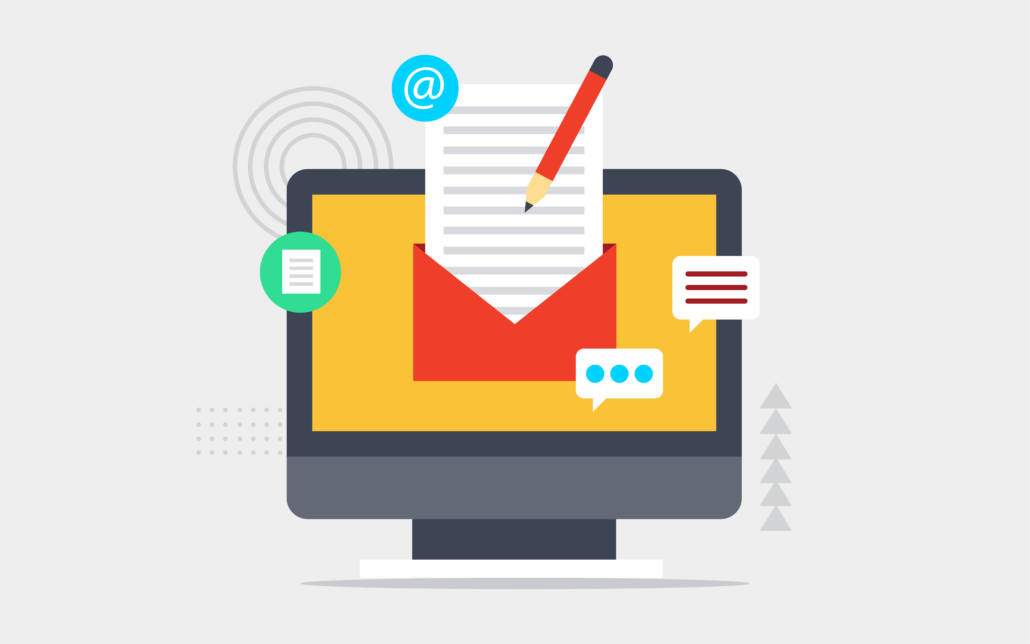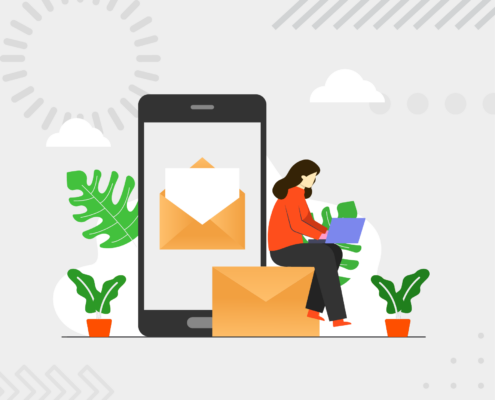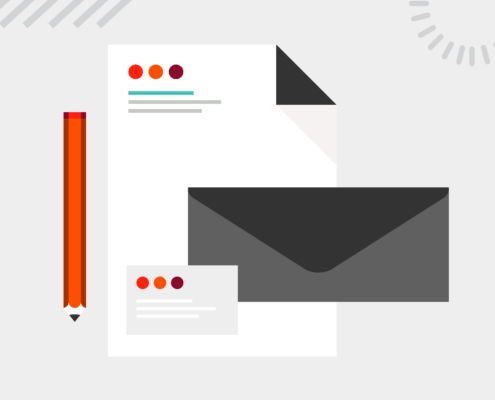

Even among the AI tools, augmented realities, and social media campaigns, print marketing is very much alive and well. There’s just something charming and familiar about holding good old-fashioned paper in your hand, and many companies are taking advantage of that by distributing printed materials like brochures, postcards, flyers, and more.
However, just printing out your logo and a quick blurb about your company isn’t enough. To get the most value out of print marketing efforts, you need to personalize those materials to your target audience. By understanding and speaking to their needs, challenges, and values, you deepen the conversation—and their connection to your brand.
Let’s explore this more together.
What’s So Great About Print Marketing?
Digital messaging is fleeting. It can go away with a click, and it’s often drowned out in a sea of competition. It’s really difficult to be heard online, but not in print. Personalized print advertising avoids the digital noise—it’s just you and the reader.
It also engages more of the senses because readers can feel the paper, smell the ink, and keep them where they can see them. This tactile experience is more memorable than seeing an ad on Facebook or scrolling down a homepage. Plus, the reader will have a physical reminder of your company as brochures sit on desks, postcards gather on kitchen tables, and business cards rest in wallets.
This doesn’t mean you should abandon the digital world altogether—not at all! It just means print is a great way to supplement your online presence. It offers a whole new way to engage your audience.
Understand Your Audience First
Personalized print advertising starts with … well, the person! You need to learn the needs, goals, and behaviors of the people you want to have as your customers. Here’s a three-step starting point:
- Gather Data – Collect information from touchpoints like purchase history, website interactions, feedback forms, and social media engagement.
- Analyze for Insight – Consider the data from these touchpoints, and pay close attention to their patterns and preferences. What do your customers value? What challenges do they face, and how are they interacting with your brand?
- Segment the Audience – Divide your audience into segments based on their preferences, demographics, and behaviors. A fitness apparel brand might have a segment of women aged 30–45 who are health-conscious with a moderate to high income, for example. If you’re an HVAC company serving commercial businesses, one of your segments might be retail store owners who are budget-conscious and looking to lower their energy costs.
Personalization Techniques in Print Advertising
Without the right touch of uniqueness, your printed marketing materials might wind up in the reader’s trash can. Here are some techniques to turn a simple piece of mail into a compelling experience:
Variable Data Printing (VDP)
This technology allows you to change elements from one printed piece to the next without slowing down the printing process. You could change an image to reflect a new demographic, or replace a testimonial with another one that better reflects the challenges of a certain customer. This way, you can cater each printed material to the recipient, making them feel genuinely valued.
QR Codes & Augmented Reality
QR codes and augmented reality features bridge the gap between print and digital materials to create a fully interactive experience. They take the reader to an online page or form when scanned with a smartphone, while augmented reality features display products in 3D through the phone screen.
Customized Offers & Discounts
Customize your promos to match the recipient’s purchase history or interests. If they’ve shown previous interest in a certain product, for example, offer a discount on that specific item. This increases the likelihood of conversion and strengthens brand loyalty.
Personalized URLs
Personalized URLs direct the reader to a webpage created just for their demographic or audience segment. These allow you to track engagement with greater precision.
Best Practices for Print Design
Design is everything in personalized print advertising. Here’s how to make sure yours hits the sweet spot:
- Make Personalization a Priority – Make sure your design accommodates elements like URLs, QR codes, custom promos, and images that reflect the audience. Each piece should feel like it was made just for the recipient.
- Keep Branding Consistent – It’s important to balance personalization with your overarching brand identity. Include the techniques listed above, but always make sure your branding is immediately recognizable in every piece. Use consistent fonts, color schemes, and logos.
- Use High-Quality Imagery & Copy – Every image you choose should be relevant to the reader. It should be a reflection of their demographics, needs, and values. If you’re targeting small local businesses, don’t use images of big corporate spaces, for example. The writing needs to be just as engaging as the design, too; use strong verbs, speak to the reader’s specific challenges, and succinctly explain the value you give them. This combination of great imagery and great copy makes every printed piece a powerful communication tool.
- Select the Right Format & Material – When choosing the format and material for your piece, consider its purpose, your audience’s preferences, and practical aspects like cost and durability. A thick semi-gloss paper is perfect for postcards, while a matte heavyweight paper is ideal for brochures.
Personalized print advertising is about more than getting noticed in a stack of mail. It’s about establishing a tangible, meaningful relationship with your audience and creating something that feels almost as special as a handwritten note.
Integrating Print Into Your Overall Marketing Strategy
Nowadays, the most successful brands provide a smooth customer experience across print and digital realms. Integrating print into your overall marketing strategy achieves just that.
Strategies for Combining Print With Digital Marketing
- Use QR Codes – A QR code leads the reader to your landing page, website, contact form, or social media platform, providing a quick and easy path from a physical material to a digital interaction.
- Support Digital Ads With Direct Mail – If you’re running an online campaign, supplement it with direct mail pieces that echo its messaging and style. Promoting a new product on Facebook? Mail out flyers highlighting its features, or coupons offering discounts. This reinforces your campaign’s scope and strength across channels.
- Turn to Social Media – Combining social media with printed materials creates a loop of conversation and engagement. A QR code could send the reader to a video on Facebook of someone unboxing your product. A call to action could encourage the reader to follow your social media accounts for a chance to win a prize. Get creative!
Tips for Creating a Cohesive Brand Experience
- Make sure your visuals (color, typography, etc.), messaging, and tone are consistent across all materials and channels, from Instagram and Facebook posts to your brochures and your website. If you’re playful in a postcard, don’t be dry and super-technical on Facebook.
- Gather customer data regularly to customize online and offline marketing materials, noting new or shifting preferences and behaviors. This makes each touchpoint feel special.
- Measure the effectiveness of your digital and print campaigns. Metrics include response rates, conversion rates, and coupon redemption rates, to name a few. This helps you optimize your messaging and make sure printed and digital efforts complement one another.
Measuring Success & Adjusting Strategies
To fully understand the impact of your personalized print advertising, you need to measure a few KPIs and adjust your approach accordingly.
Key Metrics
- Response Rate – This is the percentage of recipients who take the action you intended after they receive the printed material, whether that’s subscribing to a list, scheduling an appointment, following you on socials, or ordering a product.
- Return on Investment (ROI) – This compares the revenue generated by the campaign to its total cost, showing you how cost-effective it was.
- Customer Retention & Lifetime Value – This measures the way print marketing contributes to retaining customers and increasing their loyalty.
How to Measure ROI
- Use personalized URLs and QR codes to track online activities initiated by your printed materials.
- Create call tracking numbers just for your print campaigns to measure response rates from them.
- Conduct surveys to gauge the impact of the materials on your audience’s perception and behavior.
Using Feedback to Refine Campaigns
- Take note of which elements of your print campaign drive engagement and sales and which do not. Maybe your QR code needs to go to a new place, or readers respond well to a certain type of direct mail but not another.
- Collect customer feedback directly with follow-up calls or digital surveys after they’ve received your printed materials.
- Test different designs, messages, and offers on an ongoing basis to optimize your print marketing strategy.
Ethical Considerations & Privacy
There’s a delicate balance between personalization and privacy. As marketers, we want to enhance the customer experience—but we also don’t want to overstep any boundaries. Here are some things to keep in mind:
- Be transparent with your customers about how their data is being used to tailor their experience.
- Give recipients the option to control the amount they receive, respecting the privacy they’d like to keep.
- Stay up to date with data protection laws like the California Consumer Privacy Act and the General Data Protection Regulation. This helps you make sure customer data is collected, stored, and used responsibly.
- Use best practices for data security to protect customer info from breaches and unauthorized access. These include encryption, multi-factor authentication, employee security training, and strong passwords.
Add a Personal Touch to Your Print Marketing With Creative Sweets
At Creative Sweets, we understand the extra flavor personalization adds to your print marketing. From QR codes in brochures to bespoke URLs in postcards, we sprinkle catered messaging in every printed material we create for our clients. Our experts work with you to understand your audience’s challenges, goals, and demographics, so we can customize key elements of your print marketing and keep customers engaged.
Ready to experience the power of personalized print advertising? Reach out today!









